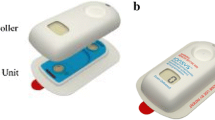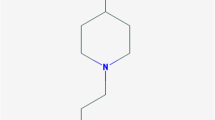Summary
Transdermal fentanyl 75 μg/h (Fentanyl-TTS) was compared with placebo in a randomized double-blind study in the early postoperative period, using 50 patients recovering from major urological operations. Analgesic efficacy was individually titrated with intravenous fentanyl by means of a PCA pump (demand dose 34 μg, lockout time 5 min). The test systems were applied 8 h before anaesthesia and were left in situ for 24 h.
During the PCA period (18.2 h) patients with Fentanyl-TTS required significantly less additional fentanyl (0.48 vs 0.93 μg · kg−1 · h−1) and reported less pain than patients in the placebo-group.
Patient acceptance was high in both groups. Side-effects were of only minor intensity and did not differ between the two groups. In particular, there was no case of clinically relevant respiratory depression.
Similar content being viewed by others
References
Aronson JK, Sear JW (1986) Transdermal hyoscine (scopolamine) and postoperative vomiting. Anaesthesia 41: 1–3
Bals-Pratsch M, Knuth UA, Yoon YD, Nieschlag E (1986) Transdermal testosterone substitution therapy for male hypogonadism. Lancet I: 943–945
v. Bormann B, Ratthey K, Schwedtlick G, Schneider C, Müller H, Hempelmann G (1988) Postoperative Schmerztherapie durch transdermales Fentanyl. Anaesth Intensivther Notfallmed 23: 3–8
Buchkremer G, Bents H, Minneker E, Opitz K (1988) Langfristige Effekte einer Kombination von transdermaler Nikotinzufuhr mit Verhaltenstherapie zur Raucherentwöhnung. Nervenarzt 59: 488–490
Caplan RA, Ready LB, Oden RV, Matsen FA, Nessly ML, Olsson GL (1989) Transdermal fentanyl for postoperative pain management. JAMA 261: 1036–1039
Caplan RA, Southam M (1990) Transdermal drug delivery and its application to pain control. Adv Pain Res Ther 14: 233–240
Chetkowski RJ, Meldrum DR, Steingold KA, Randle D, Lu JK, Eggena P, Hershmann JM, Alkjaersig NK, Fletcher AP, Judd HL (1986) Biologic effects of transdermal estradiol. N Engl J Med 314: 1615–1620
Chien YW, Piscataway NJ (1984) Pharmaceutical considerations of transdermal nitroglycerin delivery: The various approaches. Am Heart J 108: 207–216
Duthie DJR, Rowbotham DJ, Wyld R, Henderson PD, Nimmo WS (1988) Plasma fentanyl concentrations during transdermal delivery of fentanyl to surgical patients. Br J Anaesth 60: 614–618
Gourlay GK, Kowalski SR, Plummer JL, Cousins MJ, Armstrong PJ (1988) Fentanyl blood concentration-analgesic response relationship in the treatment of postoperative pain. Anesth Analg 67: 329–337
Gourlay GK, Kowalski SR, Plummer JL, Cherry DA, Gaukroger P, Cousins MJ (1989) The transdermal administration of fentanyl in the treatment of postoperative pain: pharmacokinetics and pharmacodynamic effects. Pain 37: 193–202
Gourlay GK, Kowalski SR, Plummer JL, Cherry DA, Szekely SM, Mather LE, Owen H, Cousins MJ (1990) The efficacy of transdermal fentanyl in the treatment of postoperative pain: a double-blind comparison of fentanyl and placebo systems. Pain 40: 21–28
Hackl W, Fitzal S, Lackner F, Weindlmayr-Goettel M (1986) Vergleich von Fentanyl und Tramadol zur Schmerzbehandlung mittels On-demand-Analgesie-Computer in der frühen postoperativen Phase. Anaesthesist 35: 665–671
Holley FO, van Steennis CV (1988) Postoperative analgesia with fentanyl: pharmacokinetics and pharmacodynamics of constantrate i. v. and transdermal delivery. Br J Anaesth 60: 608–613
Kay B (1981) Postoperative pain relief. Use of an on-demand analgesia computer (ODAC) and a comparison of the rate of use of fentanyl and alfentanyl. Anaesthesia 36: 949–951
Lasagna L, Greenblatt DJ (1986) More than skin deep: transdermal drug-delivery systems. N Engl J Med 314: 1638–1639
Latasch L, Lüders S (1989) Transdermal fentanyl against postoperative pain. Acta Anaesthesiol Belg 40: 113–119
Lehmann KA, Heinrich C, van Heiss R (1988) Balanced anaesthesia and patient-controlled postoperative analgesia with fentanyl: minimum effective concentrations, accumulation and acute tolerance. Acta Anaesthesiol Belg 39: 11–23
Lehmann KA (1990) Patient-controlled analgesia for postoperative pain. Adv Pain Res Ther 14: 297–324
Miser AW, Narang PK, Dothage JA, Young RC, Sindelar W, Miser JS (1989) Transdermal fentanyl for pain control in patients with cancer. Pain 37: 15–21
Moller IW, Dinesen K, Sondergard S, Knigge U, Kehlet H (1988) Effect of patient-controlled analgesia on plasma catecholamine, cortisol and glucose concentrations after cholecystectomy. Br J Anaesth 61: 160–164
Rosenberg PH, Heino A, Scheinin B (1984) Comparison of intramuscular analgesia, intercostal block, epidural morphine and on-demand i.v. fentanyl in the control of pain after upper abdominal surgery. Acta Anaesthesiol Scand 28: 603–607
Rowbotham DJ, Wyld R, Peacock JE, Duthie DJR, Nimmo WS (1989) Transdermal fentanyl for the relief of pain after upper abdominal surgery. Br J Anaesth 63: 56–59
Sebel PS, Barrett CW, Kirk CJC, Heykants J (1987) Transdermal absorption of fentanyl and sufentanyl in man. Eur J Pharmacol 32: 529–531
Simmonds MA, Blain C, Richenbacher J, Southam MA (1988) A new approach to the administration of opiates: TTS (fentanyl) in the management of pain in patients with cancer. J Pain Sympt Manag 3: S18
Suttmann H, Juhl G, Dworzak H, Ebentheuer H (1988) Patientenkontrollierte Analgesie. Eine technische Spielerei oder eine Bereicherung der Schmerztherapie? Anaesthesist 37: 543–550
Tamsen A. Prominject. In: Harmer M, Rosen M, Vickers MD; Eds (1985) Patient-controlled analgesia. Blackwell London, pp 92–93
Uppington J, Dunnet J, Blogg CE (1986) Transdermal hyoscine and vomiting. Anaesthesia 41: 16–20
Varvel JR, Shafer SL, Hwang SS, Coen PA, Stanski DR (1989) Absorption characteristics of transdermally administered fentanyl. Anesthesiology 70: 928–934
Weber MA, Drayer JIM, McMahon FG, Hamburger R, Shah AR, Kirk LN (1984) Transdermal administration of clonidine for treatment of high blood pressure. Arch Intern Med 144: 1211–1213
Welchew EA (1983) On-demand analgesia. A double blind comparison of on-demand intravenous fentanyl with regular intramuscular morphine. Anaesthesia 8: 19–25
Author information
Authors and Affiliations
Rights and permissions
About this article
Cite this article
Lehmann, K.A., Einnolf, C., Eberlein, HJ. et al. Transdermal fentanyl for the treatment of pain after major urological operations. Eur J Clin Pharmacol 41, 17–21 (1991). https://doi.org/10.1007/BF00280100
Received:
Accepted:
Issue Date:
DOI: https://doi.org/10.1007/BF00280100




